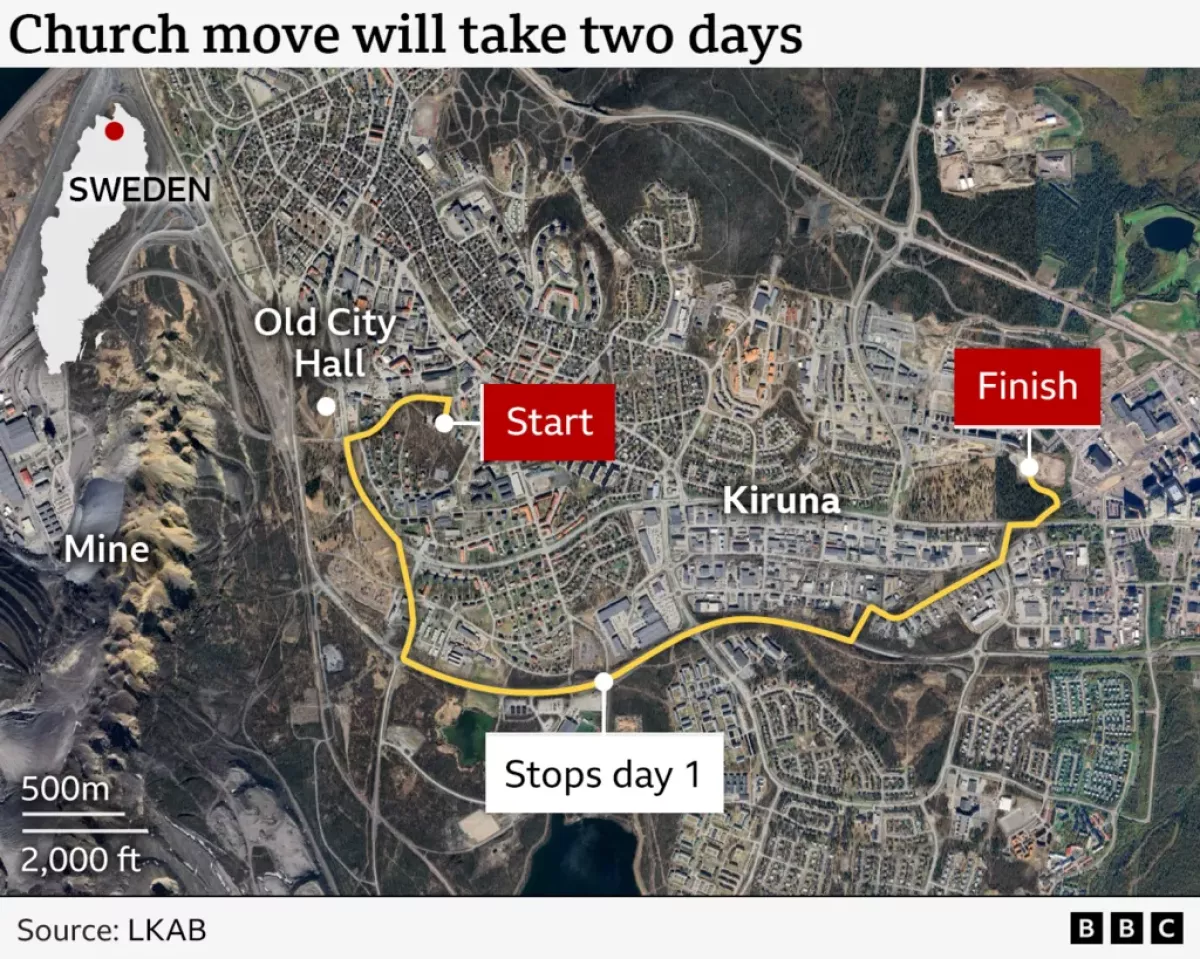Sweden moves historic church in spectacular engineering feat
A 113-year-old church in Sweden’s far north is making history of its own—by rolling five kilometres to a new home. The vast red timber structure, Kiruna Church, is being relocated in its entirety as the ground beneath the old town centre becomes increasingly unstable from more than a century of iron ore mining.
The move, described by many locals as both an engineering marvel and an emotional moment, is part of a much larger relocation of the Arctic town of Kiruna. The church—built in 1912, towering 35 metres high and weighing 672 tonnes—was once voted Sweden’s most beautiful pre-1950 building. Now, it is the most symbolic structure to be shifted as part of the billion-dollar urban migration, according to an in-depth article by BBC.
The journey began with a blessing from the church’s vicar, Lena Tjärnberg, and Bishop Åsa Nyström of the Diocese of Luleå. As the ceremony ended, the engines of the massive self-propelled trailers roared to life and the church began inching forward. In its first hour, it managed just 30 metres.
Large crowds lined the streets to witness the slow but steady progress under clear skies.
“It’s a big crowd. People came not just from Kiruna and other parts of Sweden. I heard many different languages being spoken,” culture strategist Sofia Lagerlöf Mättää told BBC. “It’s like history taking place in front of our eyes.”

The relocation is expected to take two days, with the building travelling at no more than 500 metres an hour. Project manager Stefan Holmblad Johansson, who also sings in the church’s gospel choir, acknowledged the stakes: “It’s a historic event, a very big and complex operation and we don’t have a margin of error. But everything is under control.”
Town on move
The relocation effort began in the mid-2010s, when fissures caused by the world’s largest underground iron ore mine started threatening infrastructure in Kiruna, which lies 145 kilometres north of the Arctic Circle.
Though there is no risk of people “falling through cracks,” as Robert Ylitalo, chief executive officer of Kiruna’s development company, explained, the damage would eventually compromise water, electricity and sewage systems.
“People have to move before the infrastructure fails,” he said.
Most buildings in the old town centre have already been demolished and rebuilt. But several landmarks have been preserved and shifted, such as the so-called yellow row of three old wooden houses, the former residence of mining manager Hjalmar Lundbohm, and even the clock tower from the old city hall, which now stands beside the new one.
The relocation is being paid for by the state-owned mining company LKAB, Kiruna’s largest employer, which has committed more than 10 billion Swedish krona ($1 billion) to cover the city’s transformation.
Delicate operation
Moving a 672-tonne church intact requires meticulous preparation. Engineers reinforced the structure with steel beams before lifting it onto self-propelled modular transporters.
"The biggest challenge was preparing the road for such a wide building,” said project manager Johansson. “We’ve widened it to 24 metres and along the way we removed lamp-posts, traffic lights as well as a bridge that was slated for demolition anyway.”

Special precautions have also been taken to protect the church’s treasures, including its great altar painting by Prince Eugen, a member of Sweden’s royal family.
“It’s glued directly onto a masonry wall so it would have been difficult to remove without damage. So it will remain inside the church during the move, fully covered and stabilised. So will the organ with its 1,000 pipes,” Johansson explained.
For many, the preservation of the church intact is a cultural triumph.
“I’m not a deeply religious person—I only go to church on special occasions. But this is part of my tradition, history and culture,” said onlooker Lena Edkvist, who had travelled from Gothenburg. “It feels like an honour that they’re moving it intact instead of dismantling it piece by piece.”
Bittersweet relocation
The relocation is more than a logistical exercise—it is also deeply personal.
“The church has served as a spiritual centre and a gathering place for the community for generations,” said Lagerlöf Määttä. “The move has brought back memories of joy and sorrow to us, and we’re now moving those memories with us into the future.”
For Vicar Tjärnberg, the moment is bittersweet: “The church is leaving a place where it truly belongs. Everyone knows it has to be relocated: we live in a mining community and depend on the mine. I’m grateful that we’re moving the church with us to the new city centre but there is also sorrow in seeing it leave the ground where it became a church.”
If all goes to plan, the building will reach its new home by the evening of August 20. Swedish television is broadcasting the entire event as “slow TV,” turning the careful crawl of a wooden church into a rare national spectacle.
As project manager Johansson summed up: “The church was built over a 100 years ago for the municipality by LKAB. Now we move it to the new city. There simply can’t be any other way.”
By Sabina Mammadli








